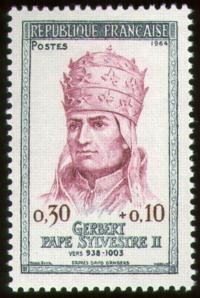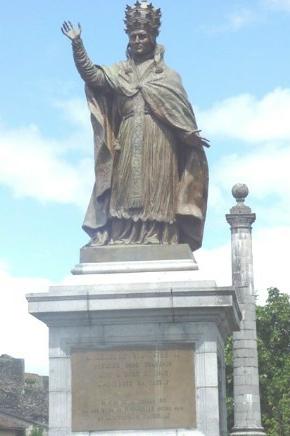 Gerbert was born in a village near Aurillac in the Auvergne (France). He received an education in grammar, arithmetic and music and probably became a monk early in his life.
Gerbert was born in a village near Aurillac in the Auvergne (France). He received an education in grammar, arithmetic and music and probably became a monk early in his life.Scholar and pope, b. c. 945 (near Aurillac, France), d. 12 May 1003 (Rome).
 Gerbert was born in a village near Aurillac in the Auvergne (France). He received an education in grammar, arithmetic and music and probably became a monk early in his life.
Gerbert was born in a village near Aurillac in the Auvergne (France). He received an education in grammar, arithmetic and music and probably became a monk early in his life.
In 967 Gerbert accompanied Count Borrell of Barcelona to Spain and stayed there for three years to study the quadruvium (music, arithmetic, geometry and astronomy) in the monastery of Santa Maria de Ripoll. In 970 he accompanied the Count to Rome, where he impressed pope John XIII with his knowledge of mathematics.
The pope introduced Gerbert to Otto I, the Holy Roman Emperor. Otto I appointed him as tutor to his son Otto II, but Gerbert felt that he was not yet sufficiently knowledgable and received permission to study logic and dialectic in Reims. Invited to teach at the cathedral school, he reorganized the course, adding some of Boëthius' works to the curriculum.
Soon Gerbert was famous well beyond Reims. His open approach to classical texts gave jealous churchmen pretexts for complaints. In 980 Otto II, who had succeeded his father as Holy Roman Emperor, organized a debate between Gerbert and Otric, headmaster of the cathedral school in Magdeburg (Saxony, Germany), on the subject of classifying knowledge. The debate became violent, and Otto II had to intervene.
Otto II appointed Gerbert to head the monastery of St. Columban of Bobbio (Italy). The monastery had one of the largest libraries of the Christian world, but hostility from monks, clerics and nobles made life difficult for Gerbert, and after Otto's death in 983 he fled the place and returned to Reims. During the following years he became embroiled in political unrest, until in 997 he left France for good and joined the court of the new Holy Roman Emperor Otto III in Aachen (Germany). At the court he worked again as a teacher and musician and worked on various practical scientific problems such as the construction of a timepiece.
In 998 Otto III appointed him archbishop of Ravenna (Italy). When Pope Gregory V died the following year, Otto III installed him as Gregory's successor. As pope Gerbert chose the name Sylvester II. He spent the rest of his life working with Otto III to expand and consolidate Christian rule across Europe.
Gerbert was a gifted teacher and great scholar. Before he turned to papal politics he had already written a treatise on the abacus that included an introduction to the Indian position-value number system, developed a chart to assist in the learning of logic, built celestial globes and other astronomical apparatus, and written about the use of the astrolabe.
Gerbert d'Aurillac spent his mature years as the head of Christianity, but this does not detract from the fact that he was a great scholar ahead of his time. He translated several works of al-Khwarizmi and other Arabic scientists into Latin and used Arabic translations of Greek works to produce Latin versions. His treatise De rationali et de ratione uti ("Concerning the Rational and the Use of Reason"), written for Otto III, was a bold attempt to classify knowledge on the basis of rational thought when religion was a powerful force in all aspects of life.
Lattin, H. P. (1995) Sylvester II. Encyclopaedia Britannica 15th ed.
The Statue of Gerbert as Sylvester II in Aurillac.
